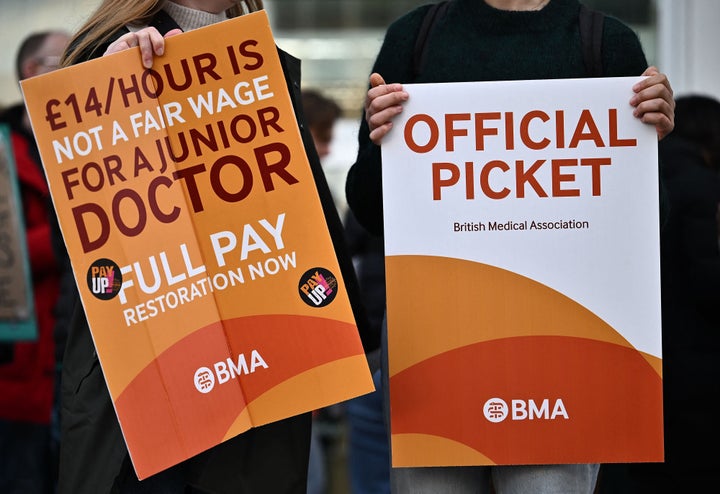The government appears to have spent more for less substantial rewards in the past.
By Kate Nicholson
12/04/2023
HUFFPOST

People hold British Medical Association (BMA) branded placards calling for better pay, as they stand on a picket line outside University College Hospital (UCH)
BEN STANSALL VIA GETTY IMAGES
A member of the BMA Union really put the pay rise the junior doctors are asking for into context during an interview with Sky News this week.
Junior doctors are in the middle of a four-day strike which is already being dubbed the most disruptive walkout in NHS history, with an estimated 250,000 appointments cancelled as a result.
Organised by the British Medical Association (BMA), the walkout comes on the back of the four-day Easter bank holiday weekend – meaning demand for services is even higher than normal.
But, the BMA says newly qualified medics earn just over £14 an hour and that their pay has fallen by 26% in real terms over the past 15 years.
RELATED NHSS KY NEWSJUNIOR DOCTORSSTRIKES UNION STRIKES
'Pricing Out An Entire Generation!' NHS Surgeon On Why Junior Doctors Turned To Strikes
It says that full pay restoration in the financial year of 2022/23 will cost £1.65 billion – with £0.62 billion returned to the Treasury for income tax and National Insurance contributions.
But the government just claimed that this works out to be a 35% pay increase, an “unreasonable” hike.
Dr Arjan Singh said: ”£37 billion was spent on a disastrous test and trace system, £4 billion on PPE that never saw the light of day and £3 billion on agency staff in the NHS – a demand that is only so high because we can’t retain doctors and start to work on a full-time NHS contract.”
It is worth noting though that – as FullFact found – around £29.5 billion was actually spent on the NHS test and trace, although it had a budget of £37 billion.
But the government did admit that it planned to burn £4 billion worth of PPE bought in the first year of the pandemic to “generate power” last June and ministers did say last year that the NHS in England had spent £3 billion on agency staff to fill gaps.
Dr Singh continued: “So the question isn’t, is it realistic to pay junior doctors, is the money there? The money is there.
“The real question we should ask is, is it realistic to expect a world-class healthcare service if you’re going to continually and vociferously cut the wages of doctors working in that system?

People hold British Medical Association (BMA) branded placards calling for better pay, as they stand on a picket line outside University College Hospital (UCH)
BEN STANSALL VIA GETTY IMAGES
A member of the BMA Union really put the pay rise the junior doctors are asking for into context during an interview with Sky News this week.
Junior doctors are in the middle of a four-day strike which is already being dubbed the most disruptive walkout in NHS history, with an estimated 250,000 appointments cancelled as a result.
Organised by the British Medical Association (BMA), the walkout comes on the back of the four-day Easter bank holiday weekend – meaning demand for services is even higher than normal.
But, the BMA says newly qualified medics earn just over £14 an hour and that their pay has fallen by 26% in real terms over the past 15 years.
RELATED NHSS KY NEWSJUNIOR DOCTORSSTRIKES UNION STRIKES
'Pricing Out An Entire Generation!' NHS Surgeon On Why Junior Doctors Turned To Strikes
It says that full pay restoration in the financial year of 2022/23 will cost £1.65 billion – with £0.62 billion returned to the Treasury for income tax and National Insurance contributions.
But the government just claimed that this works out to be a 35% pay increase, an “unreasonable” hike.
Dr Arjan Singh said: ”£37 billion was spent on a disastrous test and trace system, £4 billion on PPE that never saw the light of day and £3 billion on agency staff in the NHS – a demand that is only so high because we can’t retain doctors and start to work on a full-time NHS contract.”
It is worth noting though that – as FullFact found – around £29.5 billion was actually spent on the NHS test and trace, although it had a budget of £37 billion.
But the government did admit that it planned to burn £4 billion worth of PPE bought in the first year of the pandemic to “generate power” last June and ministers did say last year that the NHS in England had spent £3 billion on agency staff to fill gaps.
Dr Singh continued: “So the question isn’t, is it realistic to pay junior doctors, is the money there? The money is there.
“The real question we should ask is, is it realistic to expect a world-class healthcare service if you’re going to continually and vociferously cut the wages of doctors working in that system?
“The answer’s no.”
In the interview, Sky News presenter Sally Lockwood also pointed out that the BMA used the retail price index (RPI) to work out how much junior doctors’ pay has been cut.
She claimed the consumer price index “is normally used when it comes to measuring inflation for pay negotiations”, which puts the real-terms cut to doctors’ wages at 16% instead of the BMA’s suggested 26%.
She asked: “Would it not make more sense to have a more realistic demand?”
Dr Singh explained: “We use RPI – RPI is used for student loans, and junior doctors, as I’ve said, are in excess of £100,000.
“It’s also the best measure for housing costs, which is something junior doctors struggle with the most.”
The BMA has also said that health secretary Steve Barclay is refusing to negotiate and that the strikes would stop if pay was just raised to £19 an hour.
No comments:
Post a Comment